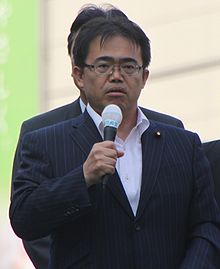Hideaki Ōmura
Hideaki Ōmura (jap. 大村 秀章, Ōmura Hideaki; * 9. March 1960 in Hekinan, Aichi Prefecture) is a Japanese politician, governor of Aichi and former member of the Shūgiin, the lower house of the national parliament, for the Tōkai proportional representation bloc. Until 2010, he was a member of the Liberal Democratic Party (LDP), within it the Nukaga faction.
Ōmura studied law at the University of Tokyo and became an official at the Ministry of Agriculture, Forestry and Fisheries after graduating in 1982. In 1995, he entered politics and became the LDP Bureau Chair for the 13th Aichi constituency, which he lost to Satoshi Shima in the 1996 Shūgiin election, but was elected via the Tōkai proportional representation bloc. He won the constituency in the three subsequent elections (by less than 400 votes in 2000), losing to Democrat Kensuke Ōnishi in 2009, but was re-elected as an MP via the bloc and was the only LDP MP from Aichi thereafter.
In 2001, after the inauguration of the first Koizumi cabinet, he became parliamentary undersecretary at the Ministry of Economy, and a year later, vice minister at the Cabinet Office, a position he was given again in the Abe cabinet in 2006, when he replaced Yoshimi Watanabe, who had been appointed minister of state. From 2009 to 2010, he was vice minister at the Ministry of Labor and Social Affairs. In the LDP, he has served as vice chairman of the parliamentary affairs committee (2008, 2010) and chairman of the Aichi Prefectural Association, among other positions.
He left the LDP in December 2010 and resigned as a deputy in January 2011 to run as an independent to succeed Masaaki Kanda in the Aichi gubernatorial election in February 2011. During the election campaign, Ōmura campaigned in particular for a ten percent reduction in the prefectural "citizen tax" (kenmin-zei). He won the February 6, 2011 election with the support of the Kōmeitō and the Genzei Nippon regional party of Takashi Kawamura, who won the mayoral election in Nagoya on the same day and achieved the dissolution of the city council in the recall referendum, against two candidates supported by the two major parties, the LDP and DPJ, and two other candidates.
For the gubernatorial election, Ōmura had formed his own party, the Nihon-ichi Aichi no Kai (日本一愛知の会, English ATJ), which supported him in the gubernatorial election and cooperated with Genzei Nippon in the April 2011 Aichi general election, winning five seats and subsequently forming a joint faction with Genzei Nippon. In the summer of 2012, Ōmura formed the Chūkyō Ishin no Kai (中京維新の会), with which he originally intended to advance into national politics through candidate nominations in the next Shūgiin election due before autumn 2013.
In 2015, Ōmura was re-elected for a second term by a four-fifths majority against only one, communist opponent.

Hideaki Ōmura 2010
Search within the encyclopedia